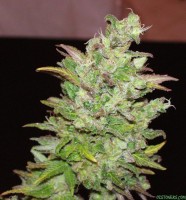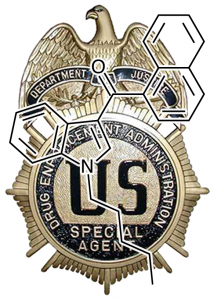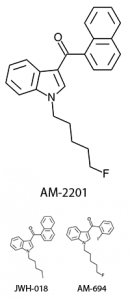Cannabinoids
Phytocannabinoids
Natural cannabinoids produced by the plant cannabis sativa.
THC (tetrahydrocannabinol),
CBD (cannabidiol),
THCV (tetrahydrocannabivarin),
CBDV (cannabidivarine),
CBN (cannabinol).
Alkylated Naphthoylindoles
The first generation of retail synthetic cannabinoids including the famed original, JWH-018.
JWH-070 (1-methyl-3-(1-naphthoyl)indole),
JWH-071 (1-ethyl-3-(1-naphthoyl)indole),
JWH-072 (1-propyl-3-(1-naphthoyl)indole),
JWH-073 (1-butyl-3-(1-naphthoyl)indole),
JWH-018 (1-pentyl-3-(1-naphthoyl)indole),
JWH-019 (1-hexyl-3-(1-naphthoyl)indole),
JWH-020 (1-heptyl-3-(1-naphthoyl)indole).
JWH-018 Replacements
Some new synthetic cannabinoids brought to prominence by the DEA emergency scheduling of JWH-018, JWH-073, JWH-200, and CP-47,497.
JWH-081 (1-pentyl-3-(4-methoxynaphthoyl)indole),
JWH-250 (1-pentyl-3-(2-methoxyphenylacetyl)indole),
RCS-4 (1-pentyl-3-(4-methoxybenzyl)indole),
AM-694 (1-(5-fluoropentyl)-3-(2-iodobenzoyl)indole).
JWH-018 4-Alkyl Substitutions
Substitution of some simple alkyl chains at the 4-position of the napthyl ring of JWH-018 can produce some highly potent (and more importantly) legal analogs.
JWH-122 (1-pentyl-3-(4-methyl-1-naphthoyl)indole),
JWH-182 (1-pentyl-3-(4-propyl-1-naphthoyl)indol),
JWH-210 (1-pentyl-3-(4-ethyl-1-naphthoyl)indol).
Phenylacetylindoles
One of the major concerns raised about the first generation synthetic cannabinoids was their napthalene ring and possible carcinogenic metabolites. The next generation phenylacetylindoles do not have a napthalene ring, and do not share this risk.
JWH-167 (1-pentyl-3-(phenylacetyl)indole),
JWH-203 (1-pentyl-3-(2-chlorophenylacetyl)indole),
JWH-249 (1-pentyl-3-(2-bromophenylacetyl)indole),
JWH-250 (1-pentyl-3-(2-methoxyphenylacetyl)indole),
JWH-251 (1-pentyl-3-(2-methylphenylacetyl)indole),
JWH-311 (1-pentyl-3-(2-fluorophenylacetyl)indole).
Halogenated and Hyperpotent
As synthetic cannabinoids moved from the underground to the mainstream, obscurity ceased to be a defense from drug enforcement authorities. Legal pressures have now created a situation where the inelastic demand of recreational drug users causes overseas manufacturers to seek the highest potency compounds in order to minimize risk of seizure.
AM-2201 (1-(5-fluoropentyl)-3-(1-naphthoyl)indole).








The most comprehensive and genuinely helpful guide I have found on the subject. Keep up the good work!
Agree with the only other comment. Comprehensive information that even a novice follow. Yes keep up the good work.